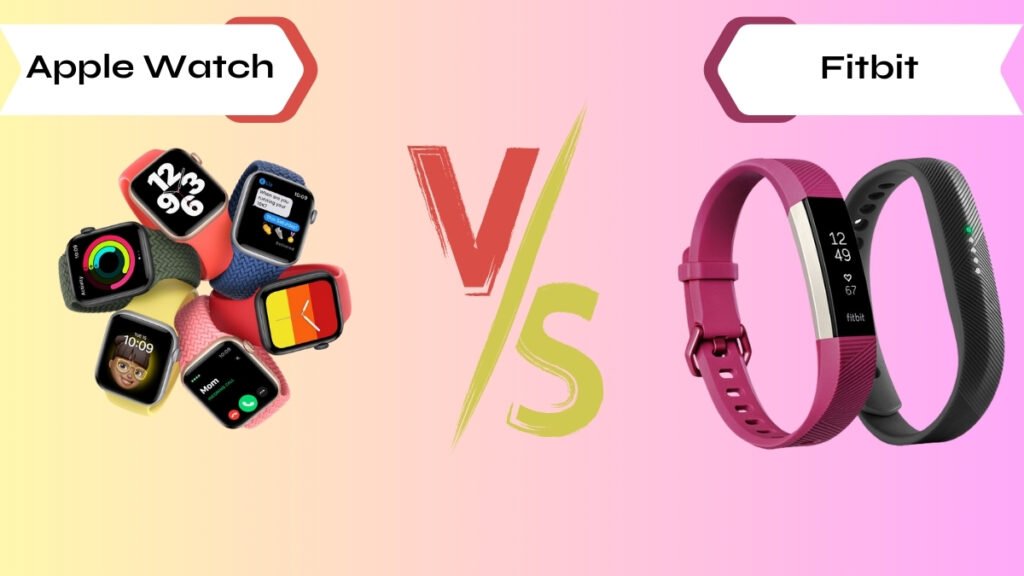Explore the ultimate showdown: Apple Watch vs Fitbit! Dive into our comparison of top smartwatches. Find your perfect fit today!
In 2015, the Apple Watch made its debut; it was a pricey, exclusive product that was primarily promoted as a luxury good. Fitbit and other fitness trackers with heart rate monitoring, step counting, and other features were already worn on people’s wrists by then. How much has changed in seven years? Which high-end fitness tracker/smartwatch therefore tops the list? The reaction is almost mixed.
The phone you currently own, your needs for a smartwatch or fitness tracker, and whether you want to upgrade or replace your smartphone all play a role in deciding which one you should choose. The final word? If you currently have an iPhone and want to combine general wellness with productivity, choose the Apple Watch. For people who are not engaged in the Apple environment and want extensive health and fitness statistics, there is the Fitbit Sense. Let’s explore more with this blog!
What is an Apple Watch?
The Apple Watch is a wearable smartwatch that has several functions that users may utilize, such as texting, reading email, and making phone calls. On April 2015, Apple unveiled the first Apple Watch. The watch was once intended by Apple to take the place of phones and cut down on the amount of time customers spent staring at their smartphones. However, the Apple Watch’s breakthroughs in health monitoring and fitness tracking, together with its compatibility with internet of things (IoT) devices, contributed to its rise in popularity.

Popular Features
Customization
The Apple Watch can be customized in a number of ways. These include selecting between models made of aluminum or stainless steel, positioning the watch face in various ways, and having a variety of armband colors and designs – for example, a sports band that is more pleasant and long-lasting for exercising.
Fitness Monitor
This function tracks the user’s heart rate while exercising, in addition to other metrics like the length of the workout and activity. Users may use Fitness+, which offers audio-guided workouts, to receive tailored coaching, create activity goals, and compete against their best saved times.
Health Monitoring
Users with atrial fibrillation can benefit from sensors that monitor ECG, blood oxygen, and heart rate data and alert users when anomalies are detected. Menstrual cycles and body temperatures can also be monitored using watches.
Apply Pay
When a user wants to make a transaction, they double-click the Digital Crown while holding the watch over a sensor. Users save their credit, debit, and prepaid cards on their watches. Some experts believe that Apple Pay is the greatest digital wallet available.
SOS and Emergency Detection
Apple Watches are able to identify falls and accidents in their users. The watch instantly notifies emergency services, shares the users’ position with them, and gets in touch with the users’ emergency contacts if the user becomes immobile. Pressing and holding the Digital Crown at any moment allows users to reach emergency services as well.
There are more features, such as sleep tracking, Siri, maps, family setup, digital keys, notifications, and messaging, available with the Apple Watch.
Learn more:
- WordPress.org vs WordPress.com – Self Hosted vs Hosted WordPress
- Evernote vs OneNote – Note Taking App Showdown
What is a Fitbit?
An activity tracker called a Fitbit is worn on the wrist like a watch. Whether you walk, run, swim, cycle, or workout at the gym, it automatically logs your daily activity and keeps the data in an app that you can quickly access on your phone. Trackers and watches are the two primary categories. Watches with smartphone compatibility include text, call, and calendar alerts. Trackers are more compact and concentrated on activity monitoring.

Popular Features
Heart Rate Tracking
Photoplethysmography (PPG) technology counts the number of beats per minute by measuring the amount of blood in your wrist using light. Until you turn it off, this number is always visible on your watch.
Exercise Monitoring
The World Health Organization (WHO) recommends 150 minutes of moderate activity or 75 minutes of intense activity per week as the minimum amount of exercise. Fitbit tracks your fat burn, cardio, and peak activity to calculate your weekly objective, which is automatically set at 150 Active Zone Minutes. You will receive one Active Zone Minute for each minute you spend in the Fat Burn Zone and two Active Zone Minutes for each minute you spend in the Cardio or Peak Zones. Your heart rate and the intensity of your workout decide which zone you’re in; you can monitor this information on the watch or tracker as you go.
Activity Tracking
A 3-axis accelerometer is used by all Fitbit watches and trackers to measure your movements. These devices employ algorithms that are made to search for particular movement patterns. An altimeter is another feature on certain gadgets that helps determine if you are going up or down stairs. Your Fitbit will calculate your steps, distance traveled, and calories burnt as you move. You can see these numbers on the face of the tracker or through the Fitbit app.
Apple Watch vs Fitbit: A Short Review
| Features | Apple Watch | Fitbit |
|---|---|---|
| Compatibility | iOS devices | iOS and Android devices |
| Design Options | Limited but diverse | Limited but diverse |
| Fitness Tracking | Advanced with ECG, HR monitoring, and more | Strong emphasis on fitness tracking features |
| Smart Features | Rich ecosystem, apps, Siri integration | Limited smart features, basic notifications |
| Battery Life | Typically 1-2 days | Varies by model, typically 4-7 days |
| Ecosystem | Integrated with Apple ecosystem | Standalone ecosystem with Fitbit app |
Read more:
Apple Watch vs Fitbit: A Detailed Review

Apple Watch vs Fitbit: Design
| Apple Watch | Fitbit |
|---|---|
| Since its 2015 introduction, the Apple Watch’s square form has undergone minimal modification. The largest and most durable screen to date (41mm and 45 mm) is seen in Series 8. | Many of Fitbit’s models continue to maintain the activity band-like design that it first adopted. The Versa 3, Versa 4, and Sense trackers feature a bigger, square front, while the Inspire 2, Charge 5, and Luxe versions are all compact trackers. |
Apple Watch vs Fitbit: Battery Life
| Apple Watch | Fitbit |
|---|---|
| The amount of time you spend using the fitness functions on your Apple Watch determines how long its battery lasts. However, if you plug it in at 8 a.m. and take it out at 7 p.m. to watch Netflix, you should typically have 40% of the power left. | The Fitbit Sense 2 and Versa 4 have a six-day battery life, with a minimum 12-minute charge to last you the remainder of the day. However, the precise time may vary according to the functions you utilize. |
Apple Watch vs Fitbit: Workout Tracking
| Apple Watch | Fitbit |
|---|---|
| The Apple Watch is equipped with an exercise tracking feature. Exercise activities like cycling, swimming, and running are measured by sensors built into the watch. The integrated GPS technology also aids in tracking variations in height and distance traveled during exercises. The Activity app for iOS devices or third-party apps like Strava or MapMyRun may then be used to display all of these stats. | Fitbit provides a range of activities for tracking, such as heart rate, steps, active minutes, and calories burnt. The built-in sensors on the gadget power these measures, which you can track using the Fitbit app. Additionally, the app gives users access to a library of workouts that can be altered to meet specific goals. Users may easily monitor their progress over time and modify their practice as necessary, thanks to this. |
Apple Watch vs Fitbit: Health and Wellness
| Apple Watch | Fitbit |
|---|---|
| Apple Watch provides you with an activity app that lets users track their daily activity by establishing objectives for how long they spend working out or how many calories they burn. Additionally, it has special functions like fall detection. | Fitbit provides consumers with a comprehensive food database to register their meals with its nutrition monitoring feature. This aids in their monitoring of the nutrients they are taking in and enables them to modify their diet for better health results. Fitbit provides breathing workouts with guidance. |
Apple Watch vs Fitbit: Location Tracking
| Apple Watch | Fitbit |
|---|---|
| If your watch has cellular service, you can use it to text and make calls without using your phone at home. The location-sharing features aren’t as sophisticated as those of companies like Garmin, though. | While GPS monitoring is theoretically possible without a phone, it’s not always reliable. The Fitbit’s GPS depends on the model; some feature built-in GPS, while others use your phone. |
Conclusion
In order to make sure that you get the most out of the gadget you choose, it is ultimately important for you to consider your unique lifestyle while choosing between two devices. Each smartwatch has benefits, but depending on your way of living life, either one may be quite helpful for tracking your health and being active. Prior to making a purchase, be sure to take into account all relevant considerations, including your preferred design style, your budget, the battery life, and the features you want. Any person may select the gadget that best fits them with the correct research.
Additional resources:
FAQs
Which is best Fitbit or Apple Watch?
Although wearables from both companies are excellent and of great quality, Fitbit offers ore alternatives at lower costs, has longer battery life, and offers better tracking for fitness and health than Apple Watch. When it comes to accuracy, ease of use, and additional capabilities, the Apple Watch beats the Fitbit, but some customers could find it to be too costly.
Does Fitbit have ECG?
An ECG is created and recorded using the Fitbit ECG app when you take a 30-second reading on your wrist-worn Fitbit device. You can examine your findings on your phone or tablet in addition to your Fitbit wrist-worn device when you use the Fitbit ECG app to analyze the data and provide the results.
Is Fitbit good for heart patients?
According to research from the University of Florida, blood pressure for persons 60 years of age or over who are at moderate to high risk of chronic heart disease were improved when physical activity increased in conjunction with the use of a Fitbit and guided exercise.





